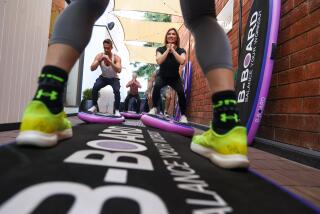SHOPTALK : Finally, Exercise You Can Do Lying Down : Bodyboarding may be just the way to get in shape this summer. But before investing up to $200 in the equipment, consider the options.
- Share via
It couldn’t have been more than five years ago--give or take a few pounds and wrinkles--that you seriously considered surfing as a recreation.
These days, though, it’s enough of a challenge to walk up a moving escalator. You can hardly picture yourself standing on a narrow board as it dips and sways atop an ocean wave.
But lying down on a board--now that’s something you’re still willing to try. So you’ve decided to go out and buy yourself a bodyboard.
Now where do you begin?
We spoke with several local surf-shop folks to find out what factors to consider.
As with most products for which you’re going to plunk down some significant cash, it might be a good idea to first determine how much wear and tear you’ll put on the board.
A quality board that will last you more than one summer at the beach goes for a minimum of $60 to $75 on up to about $200, said the experts. Less durable boards can be had for under $50.
Almost all boards are made of foam. The main difference between the cheaper boards and the more costly ones is that the latter have a plastic (or sometimes vinyl) covering (or skin) on the base.
“They are more durable than boards with raw, exposed foam on the bottom,” said Ryan Beppu, manager of the Surfin West store in Ventura. He said boards with hard or slick skins also are faster on the water because they have less resistance.
Most boards are standard in size, ranging from about 40 to 46 inches in length.
In general, said Beppu, the 40-inch boards are appropriate for riders who are about five feet tall and weigh 125 pounds or less; the 42-inch boards are good for riders between 5 feet, 2 inches and 5 feet, 8 inches and 125 to 150 pounds, and the 43-inch boards are for those 5 feet, 9 inches to 6 feet, 2 inches and 150 to 190 pounds.
Another aspect to consider when buying a board is its flexibility. Beppu said the stiffer the board, the more quickly and easily it planes through the water. The more flexible the board, the easier it is to maneuver and catch waves. He suggested the flexible boards for beginners.
Stan Fuji, owner of Ventura Surfshop, said the rider’s size is a big factor in determining board flexibility.
“A light person can use a flexible board, but a bigger, stronger person should use a stiffer board,” he said. “A larger person’s weight really can wrench a soft board and in a few weeks it can get very noodle-y.
In general, bodyboards with plastic skins will be stiffer than those without. But it’s the material from which the core of the board is made that really makes the difference.
A core material called Arcel is stiffer than the more common polyethylene core. But, Beppu said, the cold water off the Ventura County coast, which tends to stiffen boards, may make the Arcel boards a bit too stiff to use.
Have you got all that? Now before you go buy your board, we must mention accessories. First, there’s the leash. If the board you choose doesn’t have one attached, you want to seriously consider getting one. It’s a cord that attaches to the board and the rider’s wrist. That way, if the rider gets tossed from the board, the board doesn’t float away.
Fuji said a simple, straight leash can be purchased for as little as $6. A coil leash goes for about $12 to $20.


